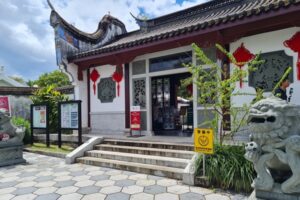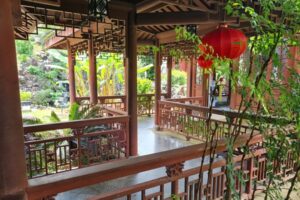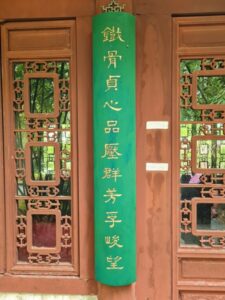Historical Background
Fukushuen Garden was built in 1992 to mark two events: the 70th anniversary of Naha City’s founding and the 10th anniversary of its sister city relationship with Fuzhou City, China. The garden was created to honor the strong historical and cultural ties between the two cities. Generations of Chinese immigrants from Fuzhou, known as the “thirty-six surnames of Kume” (also referred to as the “36 Clans of the Min-People”), settled in Naha and built lasting relationships with local residents. The garden celebrates these connections.
Design and Layout

Fukushuen covers 8,500 square meters, including the outer walls. It is divided into “three open spaces”, “four seasonal landscapes”, “eight majestic sights”, “two ponds and springs”, and a “single continuous walking path.” The garden uses design elements and materials from Fuzhou and follows traditional construction methods from the region.
The layout represents the “Eight Sights of Fuzhou” and reflects the seasonal changes through different flowers and plants. Each section is arranged to show scenes of brightness, calm, and brilliance. Key symbolic features include three mountains (Mount Yu, Mount Wu, and Mount Ping), two pagodas (White Pagoda and Bird Pagoda), and one river (Min River).
Key Features

Fukushuen is a Chinese-style courtyard garden built with traditional techniques. The structures are made entirely of wood. There are four entryways—one for each cardinal direction—each built using different construction methods from Chinese architectural tradition. The garden includes decorative windows that give visitors changing views as they walk through.
There are detailed stone carvings throughout the garden, including dragon pillars and monuments of the Eight Deities. These elements were crafted with great care, contributing to the garden’s cultural value.
Cultural Significance

Fukushuen was built to show the strong friendship between Naha and Fuzhou. It is also a tribute to the descendants of the “thirty-six surnames of Kume” and their ties to their homeland. The garden gives local residents a peaceful place to relax while connecting with the city’s history.
It serves not only as a symbol of international friendship but also as a place for cultural enrichment and quiet reflection in the city.
Construction Details
Fukushuen was designed by Fuzhou City. Construction used materials from Fuzhou, and wood and stone were processed under guidance from Fuzhou experts. The garden reflects both the technical skills and the artistic style of Fuzhou builders. Every part of the project was supervised to stay true to traditional Chinese craftsmanship.
It stands today as a lasting symbol of cooperation and respect between Naha and Fuzhou.
Video from Fukushuen Garden
Thanks for taking the time to read the article
Cheers, Gert

